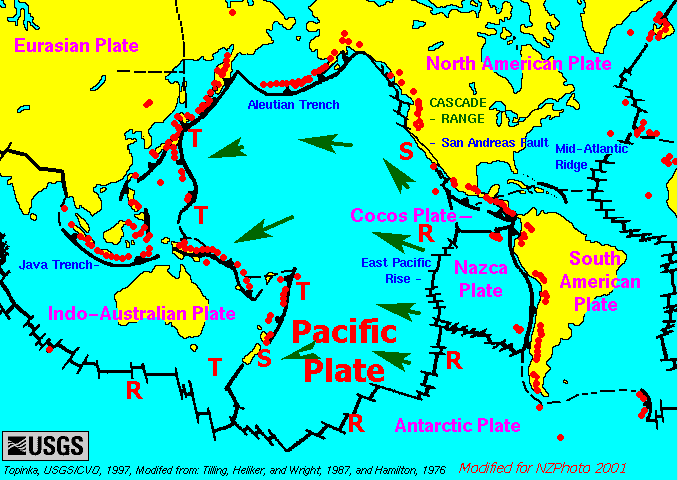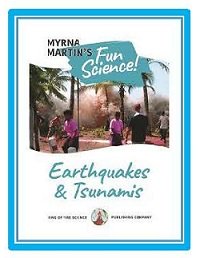Pacific Plate is an Oceanic plate
Shrinking pacific plate
Earth's largest crustal plate
The Pacific Plate is the largest crustal plate on our planet. The plate is presently shrinking as the Atlantic Ocean increases in size pushing the North American Plate slowly westward. The subduction zones surrounding the Pacific Plate are overriding the heavier and denser Pacific Plate.
Tectonic plate movement in the Pacific Ocean has created subduction zones that cause volcanoes to erupt, large subduction zone earthquakes, and tsunamis.
Recycling oceanic plates
Divergent boundaries increase the size of the oceanic plates. Subduction zones recycle the oceanic plates as they melt in the upper crust.

Pacific Plate is the largest tectonic plate on Earth
Horseshoe shaped ring of fire
Pacific Ring of Fire
The Pacific Ring of Fire is a horseshoe shaped area around the Pacific Ocean that contains subduction zones and deep trenches. The andesite line is an imaginary line that follows the subduction zones and trenches that separates composite volcanoes and shield volcanoes.
Composite volcanoes form
On the continental side of the subduction zones a towering composite volcano (stratovolcanoes) erupts rhyolite, dacite and andesite lavas. These volcanoes can be extremely explosive and deadly. The volcanoes are fueled by the subducting plates.


Click for More Information and to Order
Volcanic eruptions of composite volcanoes
Mount Pinatubo eruption
The great eruption of Mount Pinatubo in 1992 is an example of a composite volcano. The seaward side of the andesite line forms shield volcanoes of basalt form. These volcanoes are fueled by hot spots and spreading ridges where molten rock from the upper mantle flows out on the ocean floors creating basalt rocks.
Plates surround the Pacific Ocean
The Pacific Plate is surrounded by large and small crustal plates. These tectonic plate boundaries are the reason that of the 1,500 volcanoes that have been active in historic time and 90 percent of them occur in the Pacific Ocean.
Large and small earthquakes
Ninety percent of the world's earthquakes and 81 percent of the world's largest earthquakes occur in the region. Tsunamis are generated by large earthquakes and that is the reason ninety percent of the world's tsunamis also occur in the Pacific Ocean.
Size of the Pacific Ocean plate
The Pacific Plate covers about 103,300,000 square kilometers of our planet. The Pacific Ocean, which is larger, covers about one-third of the Earth. The deepest point in the oceans is located where the Mariana Plate overrides the plate creating the Mariana Trench.
Challenger Deep Dives
First dive to bottom of Challenger Deep
The Challenger Deep is at one end of the trench and is the deepest point on Earth. In June 2009 a ship found the depth to be 10,971 meters (35,994 feet) or about 6.8 miles. Jacques Picard and Navy Lieutenant Donald Walsh took the bathyscaphe Trieste to the bottom of the Challenger Deep in 1960. They stayed on a few minutes because of a crack in the glass of the bathyscaphe.
James Cameron's dive
James Cameron spent 7 years preparing for his solo descent to the depths of the Challenger Deep. He took pictures documenting his dive on March 27, 2012. He plans to return in the future. Here is a link where you can view pictures of his dive. Type into your favorite search engine James Cameron Challenger Deep Dive to watch a video of his dive.
KIDS FUN Science Bookstore
Check out Myrna Martin's award winning textbooks, e-books, videos and rock sets. The Kids Fun Science Bookstore covers a wide range of earth science topics. Click here to browse.










